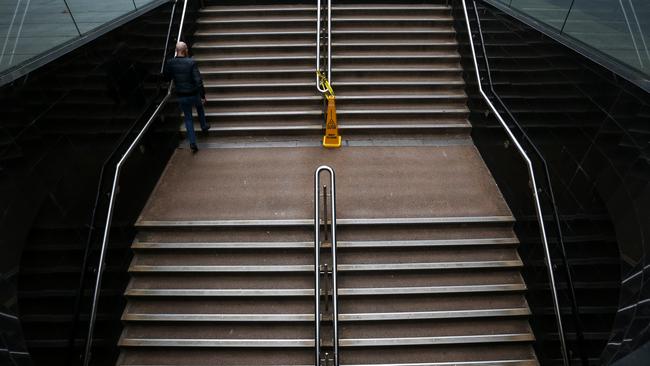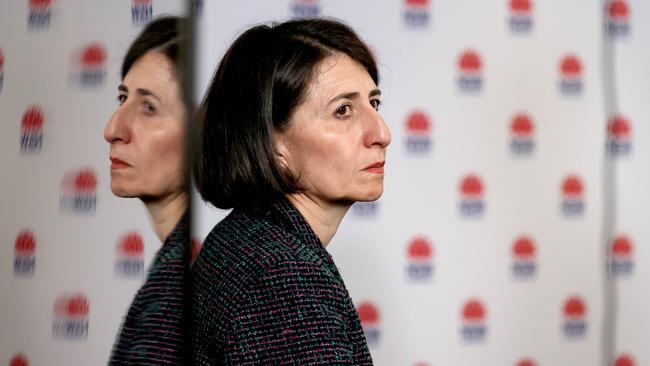For now, lockdowns part of the plan for business
Several Sydney corporate locations have been named by NSW Health as exposure sites in the past week, putting corporates at the front line of the latest outbreak.

In the 16 months since Covid-19 took up residence in Australia, large corporations have learnt to activate their pandemic response plans with a resigned acceptance, almost like fire drills.
“It’s muscle-memory now,” a Macquarie executive says, recalling events leading up to last Tuesday when NSW Health listed the group’s retail banking building in Barangaroo, Sydney as an exposure site.
The previous Saturday, NSW Premier Gladys Berejiklian tarnished her “lockdown-resistant” political brand, announcing that greater Sydney would effectively shut down for 14 days.
Macquarie’s pandemic response plan, tried and tested last year when 98 per cent of staff at one point were already working from home, was activated.
At Macquarie, when level three of its open plan Barangaroo building became an exposure site on Tuesday, it was widely assumed that a staff member had tested positive, although most people didn’t know for sure. Macquarie declined to comment.

Sydney is headquarters to a string of the nation’s biggest companies and it is also the financial hub that includes the Australian Securities Exchange and regulators the Reserve Bank of Australia and Australian Prudential Regulation Authority.
Several Sydney corporate locations have been named by NSW Health as exposure sites in the past week, putting corporates at the front line of the latest outbreak. This includes the CBD-based Bentley Resturant, ANZ in Martin Place, a Fitness First on Bond Street which edges on Sydney’s investment banking quarter, and the widely-used MLC Food Court. At the same time Sydney’s wealthy eastern suburbs remain ground zero of the latest outbreak.
Even so, the ASX operated as normal through the first week of the lockdown, with benchmark indexes celebrating the end of the financial year on Wednesday with their strongest annual performance in decades.
The only interruption to normal transmission was the ceremony for the $3bn listing of software company PEXA, which had to be held virtually.
“We’ve been there, done that in terms of running things remotely; we’ve had the capacity to do that for some time,” an ASX spokesman says.
The exchange, he says, will continue to monitor activity from a disclosure and risk management perspective, and engage with regulatory agencies and the government.
Scott Morrison responded on Friday to the rising tide of community anger and frustration about repeated state lockdowns with a four-point plan approved by national cabinet to navigate Australia out of its Covid crisis. The plan chimed with Commonwealth Bank chief executive Matt Comyn entering the fray, acknowledging the “social impacts from the uncertainty” created by border closures and hard lockdowns.

Asked if the widespread frustration extended to the business community, Comyn said there was an acceptance that “we are where we are” but it was now important to look to the future.
“I think (Victorian Premier Daniel Andrews’ comments on Thursday) were very appropriate insofar as we need to make sure we’ve given everyone an opportunity to get the vaccine,” he told ABC Radio.
“That’s the time when lockdowns will cease, so I think there’s a real clarity about what needs to get done.
“And we’re extremely focused on making sure that we can support that and facilitate the rollout rather than focusing on what’s happened up until this point.”
On cue, the Prime Minister unveiled his plan, linked in the first phase to unspecified vaccination thresholds for people older than 16.
This would be followed by a post-vaccination phase where the focus would shift from suppressing the virus to minimising serious illness and death, and then by a consolidation period with health authorities managing Covid-19 in a similar way to infectious diseases like the flu.

Finally, the country would return to normal, with no lockdowns or border closures and quarantines only for unvaccinated travellers.
The PM declined to put a timeline on the four phases, saying it would be an “evidence-led process”.
However, in return for the sign-off from state and territory leaders, he agreed to the thorny issue of a 50 per cent reduction in international arrivals to alleviate the pressure on quarantine facilities from the highly infectious Delta strain of the virus.
Ms Berejiklian’s announcement last Saturday that greater Sydney, or about 6.6 million people, would go into hibernation was greeted with predictable dread.
With the state responsible for about a quarter of gross domestic product, the estimated hit to the Australian economy from a two-week lockdown was $2bn, or 0.1 per cent of GDP. It also had an outsized impact on the nation’s business landscape.
Perth’s four-day lockdown and the three-day shutdown in Queensland, extended for a further day on Friday, were estimated to cost a further $200m and $300m, respectively.
This followed the $1.5bn hit from putting the Victorian economy into a two-week slumber from late May.
AMP Capital head of investment strategy and chief economist Shane Oliver echoed the thoughts of many when he said ongoing lockdowns seemed like groundhog day.
“Some even think the lockdowns themselves are the problem – that Australia has become paranoid, going into lockdown and shutting borders at the whiff of a new case, locking out the rest of the world and becoming a ‘lost kingdom of the South Pacific’,” Dr Oliver said.
“But Australia has made some mistakes. High on the list is the slow rollout of vaccines, the management of the returned traveller quarantine system, and the poor treatment of Australians overseas, particularly those recently in India.
“And we arguably have been too slow in relation to starting some lockdowns – in Victoria mid-last year and recently in NSW – risking longer lockdowns.
“But gloomy as it all seems, Australia’s approach has led to relatively fewer deaths and a stronger economy.”
Fewer deaths and a stronger economy are worthy of celebration. However, the sense of policy chaos became increasingly widespread earlier this week, as premiers lined up to tear strips off Mr Morrison over the inadequate hotel quarantine system and the safety or otherwise of the AstraZeneca vaccine.
As the Committee for Sydney noted, we were back into familiar lockdown territory, but the public mood had darkened and tolerance was in short supply.
“People are angrier because 16 months in, we still don’t have the settings right,” the pro-business Committee for Sydney said.
“It didn’t have to be this way if Australia had got its vaccine procurement right from the start.
“The current spike of cases in Sydney has made one thing very clear: vaccines are our ticket to freedom.
“Better quarantine arrangements, better public health orders – these are all important, but the only way we unleash the recovery is to get everyone vaccinated.”
Worryingly for the nation’s critical mining industry, the latest outbreak also tore through the defences of regional Australia, in particular Newmont’s Tanami operations in the Northern Territory.
The closure of Tanami left about 700 workers stranded in lockdown in the camp at the remote mine until at least July 10, and potentially longer if another case is detected. It was the first time since the pandemic began that a major mine has been shut due to an outbreak and, as the fourth largest gold operation in the country in 2020, the enforced shutdown of Tanami is likely to put a dent in Newmont’s Australian results this year.
But the freak incident, caused by a worker in transit from Covid-free Bendigo in Victoria who was forced by Queensland police to temporarily isolate in a hotel with international arrivals, has also left the industry scrambling to decide whether their own site protocols need to be tightened.
The nation’s mining sector was allowed to remain open throughout the early stages of the pandemic, even as states and territories shut other major industries for fear the virus would spread through the community.
The industry has long boasted that its internal controls are the strongest in the country.
It was among the first in Australia to roll out testing, including rapid antigen tests, to screen workers before they arrived on site, and has generally maintained strict controls on workers arriving in remote camps.
But the industry is closely watching the investigation into the circumstances that led to the Tanami outbreak to decide whether those controls need to be tightened again, given how quickly and easily the Delta variant can spread.
Top-level restrictions – potentially including a 72-hour quarantine period when workers arrive on site, which might have prevented the freak circumstances at Tanami – are seen as too costly to implement.
It’s all the more reason to roll out Mr Morrison’s plan quickly as possible.






To join the conversation, please log in. Don't have an account? Register
Join the conversation, you are commenting as Logout